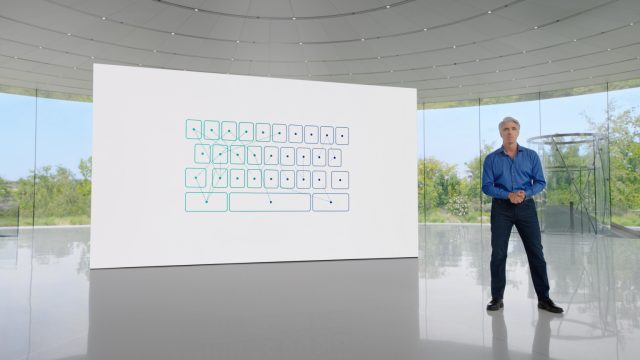
Amid impressive new products like the Apple Silicon Mac Pro and the Apple Vision Pro revealed at Monday's WWDC 2023 keynote event, Apple presenters never once mentioned the term "AI," a notable omission given that its competitors like Microsoft and Google have been heavily focusing on generative AI at the moment. Still, AI was a part of Apple's presentation, just by other names.
While "AI" is a very ambiguous term these days, surrounded by both astounding advancements and extreme hype, Apple chose to avoid that association and instead focused on terms like "machine learning" and "ML." For example, during the iOS 17 demo, SVP of Software Engineering Craig Federighi talked about improvements to autocorrect and dictation:
Autocorrect is powered by on-device machine learning, and over the years, we've continued to advance these models. The keyboard now leverages a transformer language model, which is state of the art for word prediction, making autocorrect more accurate than ever. And with the power of Apple Silicon, iPhone can run this model every time you tap a key.
Notably, Apple mentioned the AI term "transformer" in an Apple keynote. The company specifically talked about a "transformer language model," which means its AI model uses the transformer architecture that has been powering many recent generative AI innovations, such as the DALL-E image generator and the ChatGPT chatbot.
A transformer model (a concept first introduced in 2017) is a type of neural network architecture used in natural language processing (NLP) that employs a self-attention mechanism, allowing it to prioritize different words or elements in a sequence. Its ability to process inputs in parallel has led to significant efficiency improvements and powered breakthroughs in NLP tasks such as translation, summarization, and question-answering.
Apparently, Apple's new transformer model in iOS 17 allows sentence-level autocorrections that can finish either a word or an entire sentence when you press the space bar. It learns from your writing style as well, which guides its suggestions.
All this on-device AI processing is fairly easy for Apple because of a special portion of Apple Silicon chips (and earlier Apple chips, starting with the A11 in 2017) called the Neural Engine, which is designed to accelerate machine learning applications. Apple also said that dictation "gets a new transformer-based speech recognition model that leverages the Neural Engine to make dictation even more accurate."

During the keynote, Apple also mentioned "machine learning" several other times: while describing a new iPad lock screen feature ("When you select a Live Photo, we use an advanced machine learning model to synthesize additional frames"); iPadOS PDF features ("Thanks to new machine learning models, iPadOS can identify the fields in a PDF so you can use AutoFill to quickly fill them out with information like names, addresses, and emails from your contacts."); an AirPods Adaptive Audio feature ("With Personalized Volume, we use machine learning to understand your listening preferences over time"); and an Apple Watch widget feature called Smart Stack ("Smart Stack uses machine learning to show you relevant information right when you need it").
Apple also debuted a new app called Journal that allows personal text and image journaling (kind of like an interactive diary), locked and encrypted on your iPhone. Apple said that AI plays a part, but it didn't use the term "AI."
"Using on-device machine learning, your iPhone can create personalized suggestions of moments to inspire your writing," Apple said. "Suggestions will be intelligently curated from information on your iPhone, like your photos, location, music, workouts, and more. And you control what to include when you enable Suggestions and which ones to save to your Journal."
Finally, during the demo for the new Apple Vision Pro, the company revealed that the moving image of a user's eyes on the front of the goggles comes from a special 3D avatar created by scanning your face—and you guessed it, machine learning.
reader comments
74